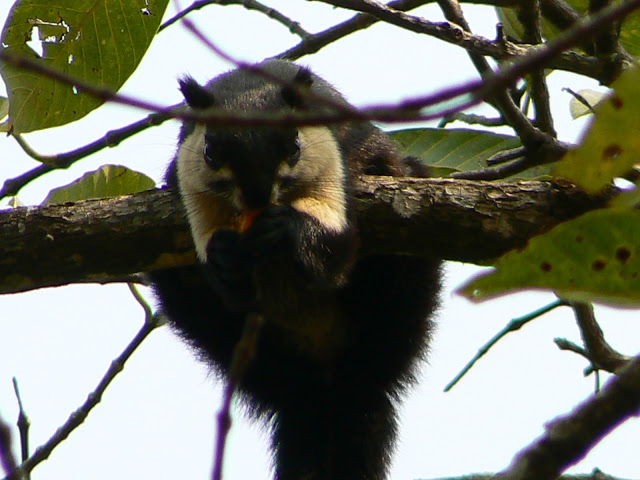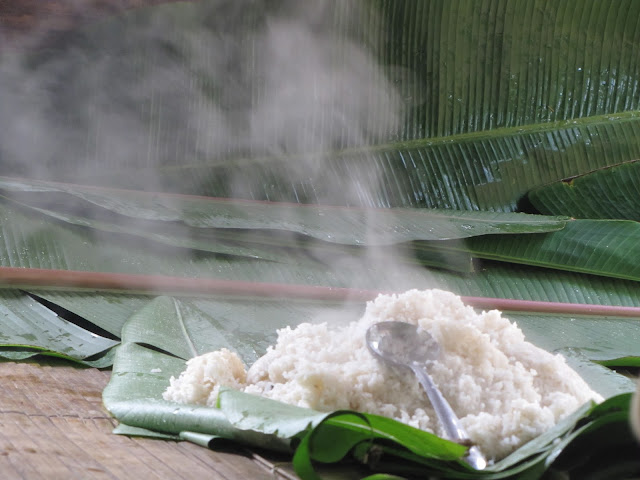A world unto itself
This piece finds place in TERRASCAPE, September 2013 issue.
Which are the interesting
places to visit in north-east India? What is the best time to visit them? Does
wildlife occur in forests there? Are people there friendly? These were amongst
the questions I have faced more than once. My first response has, on most
occasions, been that there is nothing like north-east India. In other words it
is incorrect to paint the entire region with the same brush; more so, when it has
been long acknowledged to culturally and linguistically among the richest and
most diverse regions in Asia. I feel
lucky to have enjoyed life at two amazing places in the region over a period of
eight years. This is more on account of its amazing people than its abundant
natural resource wealth. These two places, Baghmara (Meghalaya) and Saiha
(Mizoram), I share with the readers ahead.
Baghmara gets
its name from a leader having slain a tiger (bagh) long time ago, while Saiha in Mizo language means ivory; sai stands for elephant and ha for teeth. These names are no
exception in a region where lifestyle of the people is intricately linked to
the floral and faunal species they share the landscape with. Both Baghmara and
Saiha lie on international border. From Baghmara one can see the low lying
hills on the Indian side gently melt into the fertile Bangladeshi plains while
forests of Saiha conjoin the larger and equally dense forests of Myanmar. Both
these places are also far from their state capitals, Shillong (Meghalaya) and
Aizawl (Mizoram), respectively. While driving from Guwahati (Assam) to Baghmara
one passes through verdant paddy fields, while the drive from Aizawl to Saiha
has jhum (shifting or slash and burn cultivation) fields of varying ages
abutting the road. The two places are governed under Schedule 6 of the Indian Constitution.
This, in simple terms, means that they have a council of ministers functioning
under the state government! Remoteness of these places has enabled them to
retain that ‘something’ over the years.
Baghmara.
Baghmara, one of
our more beautiful district headquarters, also houses the Pitcher Plant
Wildlife Sanctuary. Locally known as Memang
Koksi this carnivorous plant is also seen alongside some of the many
streams that literally run all over the place. We had tough times spotting it
inside the Sanctuary though! The ‘Flora of British India’ published during late
1800’s describes parts of the Sate as “some of the richest botanical habitats
of Asia”. Baghmara lies in the South Garo Hills district, which also boasts of
the largest protected area in the State, Balpakram National Park. While the
splendor of its canyon is to be seen to be believed its dense evergreen forests
render it difficult for one to sight mammals even during daylight. Some of the
mammal sightings I had in the landscape I still recall with fondness. The
Capped Langurs we saw as we bathe in a stream – they were as happy on trees as
we were in the stream; the Asian Elephant that chased our bike – scaring our
wits far and fast; the Malayan Giant Squirrel that looked at us with intrigue
that matched ours, and, the Slow Loris which would have wondered why some two-legged
creatures needed to walk on a forest road with torches at night! Then of course
were the Barking Deers – also heard at late evenings in the villages. Some of
these sightings were in the Baghmara Reserve Forest – a lovely patch of forest
abutting the town.
Life at Baghmara
constituted much more than loitering in the forests. People playing table games
was a pleasant sight as we moved around town and I have pleasant memories of
playing chinese checkers with the aunty next door, who was also our landlady. Villages
smelled of jackfruits in one season, while during another oranges use to sneak
in during conversations; and how we liked them!
Garo Hills is
the place for citrus species, I was told during my initial days here. Weekly
markets were fun too; with the one on Monday being senior to the one on
Thursday. Many a time we used to come across senior government servants too -
procuring their weekly stock. Christmas was as lively a festival as I have
seen. During the day we got to savour lovely cakes at homes, and at night we moved
to nearby localities where people would sing and dance around bonfires. During
the days leading to New Year each locality would organize a dinner, which was cooked
collectively. Garos (tribe) also celebrate Wangala or the ‘Festival of Hundred Drums’.
In recent years state government has initiated Winter Festival on Simsang beach
– adding to the celebrations!
Siju too is of
interest. Simsang separates Siju Cave System (one of the longer ones we have)
from the Siju Wildlife Sanctuary (part of the Balpakram Siju Complex, an Important
Bird Area) before it flows into Bangladesh. Once it crosses the border it is
the Someshwari! Initiatives like the Siju Ecotourism and Conservation Society
based at Siju, have taken shape during recent years making sincere attempts to generate
conservation-friendly livelihoods. Baghmara too has garnered fame as a sought-after
destination for butterflies.
Law of averages
plays a role here as well. Baghmara is infamous on account of an insurgent
group that time and again tries to cause unrest while the coal mafia threatens
to relegate one of the most biodiversity rich zones we have to pages of
history.
Saiha.
Saiha is peopled
by the Mara tribe, also know as Lakhers, meaning weavers. They weave amazing
wrap-arounds and shawls even today and many a piece is on display when people go
to Church on Sunday mornings. These weaves and their processes (again different
for each tribe!) are nicely put on display at some of the State Museums in the
region. These were places of high interest to me since they brought forth
elements of life as it used to be not very long back.
It is while
moving around in this region that I have had some of my magical wildlife
moments. I encountered the Yellow Bellied Weasel twice, the Northern Treeshrew
I saw right outside the office window and it stayed on campus for few days,
Civets we saw on the road more than few times and three Leopard Cats I came
across were road kills! During a survey we saw also the Hoolock Gibbons. This
survey enabled me to see some of the densest forests and the ten days during
the exercise when we did not halt in a village is perhaps the longest stretch of
time where I have not come across plastic – such is the remoteness!
Saiha harbours the
Palak Lake (also an Important Bird Area) while Lawngtlai its neighbouring
district is home to the Blue Mountain National Park and Ngengpui Wildlife
Sanctuary – amazing wildernesses. As we travelled in villages abutting these protected
areas villagers share of their frequent encounters with Himalayan Black Bears
in the former and Asian Elephants in the later. One of the first missionaries
to the land describes these forests thus “The river wound in and out so much
that one could not see that more than a mile ahead, while the banks of the
rivers were covered in dense jungle, reaching down to the waters edge, and the
trees …”.
I recall fondly the
time I put in at tea-stalls here; sipping cups of hot tea and also gulping
locally made snacks. Tea-stalls in market area in town used to open with other
shops at five in the morning! Also right up the memory ladder, are the markets I
saw and stopped at along the road-side; state government has constructed quaint
looking sheds for these. From finger-sized brinjals to freshly cut pineapples
these markets had them all. I was though partial to passion fruit (and its
juice)!
Food in the
villages was lovely for the vegetarian in me (another of the most-asked questions!);
from pumpkin (and its leaves) and maize grown in jhum fields to mustard
cultivated in homesteads. The city bred me was floored by the taste of food
cooked on fire! Youth associations had their annual gatherings and they were
kind enough to have us partake more than our fair share of fun. The camaraderie
and energy at these events were infectious!
The state
government has a number of tourist lodges across the state, including at Saiha,
which besides being at enviable locations offer reasonably affordable options
to board and lodge. One at Aizawl used to be cold, clouds co-occupied the
rooms, but the huge (a Maruti 800 could roll over easily!) and open corridors, staff
and location more than made up for it. Since one is to drop in at Aizawl on way
to Saiha it may be of interest to make a trip to Dampha Tiger Reserve. One of
the older tiger reserves in the region, and camera trapping in recent times has
revealed a spectacular diversity of mammals moving around in dense vegetation amidst
the rugged terrain.
Recent trips to
Mokokchung and Zunheboto in Nagaland reinforced the belief of each place being
different from another; these were so different from the pockets of Meghalaya
and Mizoram that I have experienced! Nagaland is home to 16 tribes; identity of
each of these is reflected in aspects ranging from their languages to shawl
designs! I have been told these are interestingly brought forth during the
Hornbill Festival. Strength, as Stephen Covey said, lies
in differences, not in similarities. It is this heterogeneity one looks forward
to soak in when one visits different pockets of the region! I have learnt a lot
from the region and look forward to more experiences with people and forests there.
People have been ever different from each other but very rarely indifferent to
me!
Many thanks to TerraScape and Jay.






Loved this post...so much info ..and eye opener to the little known gems of North East. Thanks for sharing on the virtual world!!
ReplyDeleteMany thanks Geetanjali for dropping by; comments like your encourage to write more ~
ReplyDeleteVery nice writing !
ReplyDeleteMany thanks Asif, those were amazing times and happy if I have been able to bring out a fraction of the beauty ~
Delete